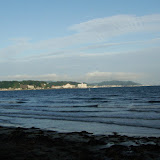Knowing Kamakura's reputation as a beach town, I was excited to arrive on a bright, sunny afternoon, and after finding and checking into my hostel I asked for the nearest beach and hustled to take advantage of the remaining light. Walking from the road to the small bay not five minutes from the hostel, I saw surfers galore, validating my beachy ambitions, and I made double-time down the steps of the public access, only to find a rather unappealing beach. The bay itself was beautiful, but the beach was rocky, and littered with debris, of both the seaweed and trash varieties. Walking down the beach in hopes of finding a better spot I found two dead and bloody seagulls, effectively killing the remainder of my beach desires. I contented myself walking up and down the shore, looking for sea glass, on special request from Sarah. Above: The view from the beach
As dusk crept on, I ventured back up to the road to read on a bench and watch the sunset--over the land, disappointingly enough--and on my way I passed a 'Beware of Hawks' sign, which explained both the dead seagulls and the paucity of sunbathers. Looking overhead I did see several hawks hovering effortlessly and looking out to sea, taking advantage of the last of the day's thermals rising from the beach. Above: The sun sets on a monument near the beach
The next day I toured all of the major temples in the area and was blown away by the architecture and the scenery. The majority of the temples are located to the north of the actual town, nestled into the mountainside, and can be connected via a hiking course. It rained throughout the day, and the lush green mountains' peaks were usually obscured by fog, lending an otherworldly feel to the sacred spaces. This was negated somewhat by the flocks of tourists. It's common practice for elementary and junior high students to get steep discounts at religious and historical tourist sites, to promote field trips, and it is an incredibly effective policy. In the course of the day I saw no less than 30 school groups. The students look very serious in their uniforms, but this solemnity is quickly corrected by the chorus of enthusiastic 'hellos' I got from a third of the students. After an acknowledgement, either through a wave, or a greeting, they would inevitably bid me a formulaic--although equally enthusiastic--farewell of 'see you'. Above: Hard rain falls on the garden at Engakuji temple
One temple I visited had the most beautiful hydrangeas I've ever seen, and had rows upon rows of them in their gardens, but the place was so popular that moving through the gardens was like waiting on line at Disney World, and getting a photo without a tourist's disembodied limb was a challenging task. Nevertheless, the sights were incredible, particularly the daibutsu, the great Buddha, statue, which at the time I thought was the largest Buddha statue in Japan. I would discover my mistake a few days later, in Nara, at the actual largest Buddha statue in Japan. Nevertheless, the daibutsu in Kamakura is no slouch, being in the open air actually makes it feel larger than its counterpart in Nara, and being able to go into the hollow interior of the statue gives it extra points in my book. Above: Me with the daibutsu. I'm standing too far forward to get a good sense of scale--plus, I'm pretty tall. This statue is massive.
Overall, Kamakura was a beautiful town, and a great experience, even if I didn't get my beach time!
More photos:









No comments:
Post a Comment